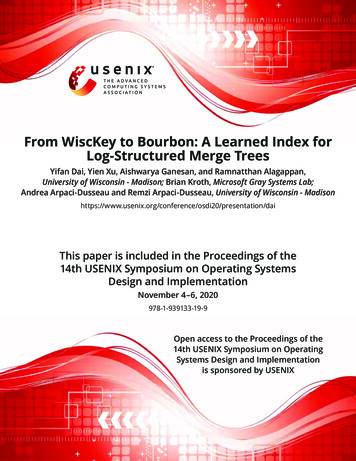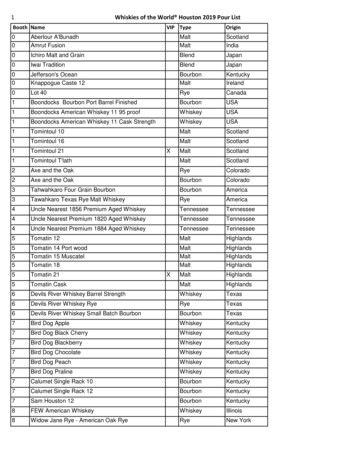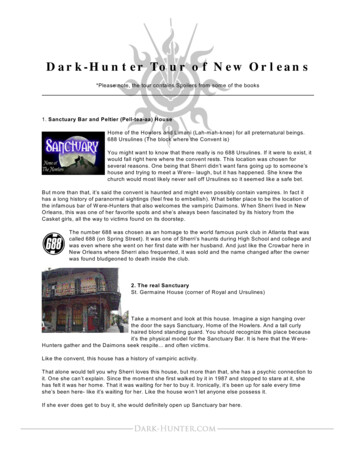
Transcription
From WiscKey to Bourbon: A Learned Index forLog-Structured Merge TreesYifan Dai, Yien Xu, Aishwarya Ganesan, and Ramnatthan Alagappan,University of Wisconsin - Madison; Brian Kroth, Microsoft Gray Systems Lab;Andrea Arpaci-Dusseau and Remzi Arpaci-Dusseau, University of Wisconsin - esentation/daiThis paper is included in the Proceedings of the14th USENIX Symposium on Operating SystemsDesign and ImplementationNovember 4–6, 2020978-1-939133-19-9Open access to the Proceedings of the14th USENIX Symposium on OperatingSystems Design and Implementationis sponsored by USENIX
From WiscKey to Bourbon: A Learned Index for Log-Structured Merge TreesYifan Dai, Yien Xu, Aishwarya Ganesan, Ramnatthan Alagappan, Brian Kroth† ,Andrea C. Arpaci-Dusseau, and Remzi H. Arpaci-DusseauUniversity of Wisconsin – MadisonAbstract. We introduce B OURBON, a log-structured merge(LSM) tree that utilizes machine learning to provide fastlookups. We base the design and implementation ofB OURBON on empirically-grounded principles that we derivethrough careful analysis of LSM design. B OURBON employsgreedy piecewise linear regression to learn key distributions,enabling fast lookup with minimal computation, and appliesa cost-benefit strategy to decide when learning will be worthwhile. Through a series of experiments on both syntheticand real-world datasets, we show that B OURBON improveslookup performance by 1.23 -1.78 as compared to stateof-the-art production LSMs.1IntroductionMachine learning is transforming how we build computer applications and systems. Instead of writing code in the traditional algorithmic mindset, one can instead collect the properdata, train a model, and thus implement a robust and general solution to the task at hand. This data-driven, empiricalapproach has been called “Software 2.0” [26], hinting at aworld where an increasing amount of the code we deploy isrealized in this manner; a number of landmark successes overthe past decade lend credence to this argument, in areas suchas image [32] and speech recognition [24], machine translation [46], game playing [44], and many other areas [7,15,17].One promising line of work, for using ML to improvecore systems is that of the “learned index” [31]. This approach applies machine learning to supplant the traditionalindex structure found in database systems, namely the ubiquitous B-Tree [9]. To look up a key, the system uses a learnedfunction that predicts the location of the key (and value);when successful, this approach can improve lookup performance, in some cases significantly, and also potentially reduce space overhead. Since this pioneering work, numerousfollow ups [13, 20, 30] have been proposed that use bettermodels, better tree structures, and generally improve howlearning can reduce tree-based access times and overheads.However, one critical approach has not yet been transformed in this “learned” manner: the Log-structured MergeUSENIX Association†Microsoft Gray Systems LabTree (LSM) [37, 39, 42]. LSMs were introduced in thelate ’90s, gained popularity a decade later through work atGoogle on BigTable [8] and LevelDB [22], and have become widely used in industry, including in Cassandra [33],RocksDB [18], and many other systems [21,38]. LSMs havemany positive properties as compared to B-trees and theircousins, including high insert performance [11, 37, 40].In this paper, we apply the idea of the learned index toLSMs. A major challenge is that while learned indexes areprimarily tailored for read-only settings, LSMs are optimizedfor writes. Writes cause disruption to learned indexes because models learned over existing data must now be updatedto accommodate the changes; the system thus must re-learnthe data repeatedly. However, we find that LSMs are wellsuited for learned indexes. For example, although writesmodify the LSM, most portions of the tree are immutable;thus, learning a function to predict key/value locations canbe done once, and used as long as the immutable data lives.However, many challenges arise. For example, variable keyor value sizes make learning a function to predict locationsmore difficult, and performing model building too soon maylead to significant resource waste.Thus, we first study how an existing LSM system, WiscKey [37], functions in great detail (§3). We focus on WiscKey because it is a state-of-the-art LSM implementation thatis significantly faster than LevelDB and RocksDB [37]. Ouranalysis leads to many interesting insights from which wedevelop five learning guidelines: a set of rules that aid anLSM system to successfully incorporate learned indexes. Forexample, while it is useful to learn the stable, low levels inan LSM, learning higher levels can yield benefits as well because lookups must always search the higher levels. Next,not all files are equal: some files even in the lower levelsare very short-lived; a system must avoid learning such files,or resources can be wasted. Finally, workload- and dataawareness is important; based on the workload and how thedata is loaded, it may be more beneficial to learn some portions of the tree than others.We apply these learning guidelines to build B OURBON, a14th USENIX Symposium on Operating Systems Design and Implementation155
2.1 LSM and LevelDBAn LSM tree is a persistent data structure used in key-valuestores to support efficient inserts and updates [39]. UnlikeB-trees that require many random writes to storage upon updates, LSM trees perform writes sequentially, thus achievinghigh write throughput [39].An LSM organizes data in multiple levels, with the sizeof each level increasing exponentially. Inserts are initiallybuffered in an in-memory structure; once full, this structure1565 LoadDBmemorydisksstablesindex blockL0L1L2candidate-1candidate-2filter blockdata-block 1.L6candidate-3data-block 2.We first describe log-structured merge trees and explain howdata is organized in LevelDB. Next, we describe WiscKey, amodified version of LevelDB that we adopt as our baseline.We then provide a brief background on learned indexes.2 LoadIB FBdata-block n(a) LevelDBsstablevalue-logkey1key2.Background1 FindFiles6 SearchDB3 SearchIB 4 SearchFB 7 -index implementation of WiscKey (§4). B OURBONuses piece-wise linear regression, a simple but effectivemodel that enables both fast training (i.e., learning) and inference (i.e., lookups) with little space overhead. B OURBONemploys file learning: models are built over files giventhat an LSM file, once created, is never modified in-place.B OURBON implements a cost-benefit analyzer that dynamically decides whether or not to learn a file, reducing unnecessary learning while maximizing benefits. While mostof the prior work on learned indexes [13, 20, 31] has madestrides in optimizing stand-alone data structures, B OURBONintegrates learning into a production-quality system that isalready highly optimized. B OURBON’s implementation addsaround 5K LOC to WiscKey (which has 20K LOC).We analyze the performance of B OURBON on a range ofsynthetic and real-world datasets and workloads (§5). Wefind that B OURBON reduces the indexing costs of WiscKeysignificantly and thus offers 1.23 – 1.78 faster lookupsfor various datasets. Even under workloads with significantwrite load, B OURBON speeds up a large fraction of lookupsand, through cost-benefit, avoids unnecessary (early) modelbuilding. Thus, B OURBON matches the performance of anaggressive-learning approach but performs model buildingmore judiciously. Finally, most of our analysis focuses onthe case where fast lookups will make the most difference,namely when the data resides in memory (i.e., in the filesystem page cache). However, we also experiment withB OURBON when data resides on a fast storage device (an Optane SSD) or when data does not fit entirely in memory, andshow that benefits can still be realized.This paper makes four contributions. We present the firstdetailed study of how LSMs function internally with learningin mind. We formulate a set of guidelines on how to integratelearned indexes into an LSM (§3). We present the design andimplementation of B OURBON which incorporates learned indexes into a real, highly optimized, production-quality LSMsystem (§4). Finally, we analyze B OURBON’s performance indetail, and demonstrate its benefits (§5).(b) WiscKeyFigure 1: LevelDB and WiscKey. (a) shows how data isorganized in LevelDB and how a lookup is processed. Thesearch in in-memory tables is not shown. The candidate sstables are shown in bold boxes. (b) shows how keys and valuesare separated in WiscKey.is merged with the first level of on-disk data. This procedureresembles merge-sort and is referred to as compaction. Datafrom an on-disk level is also merged with the successive levelif the size of the level exceeds a limit. Note that updates donot modify existing records in-place; they follow the samepath as inserts. As a result, many versions of the same itemcan be present in the tree at a time. Throughout this paper,we refer to the levels that contain the newer data as higherlevels and the older data as lower levels.A lookup request must return the latest version of an item.Because higher levels contain the newer versions, the searchstarts at the topmost level. First, the key is searched for inthe in-memory structure; if not found, it is searched for inthe on-disk tree starting from the highest level to the lowestone. The value is returned once the key is found at a level.LevelDB [22] is a widely used key-value store built using LSM. Figure 1(a) shows how data is organized in LevelDB. A new key-value pair is first written to the memtable;when full, the memtable is converted into an immutable tablewhich is then compacted and written to disk sequentially assstables. The sstables are organized in seven levels (L0 beingthe highest level and L6 the lowest) and each sstable corresponds to a file. LevelDB ensures that key ranges of differentsstables at a level are disjoint (two files will not contain overlapping ranges of keys); L0 is an exception where the rangescan overlap across files. The amount of data at each levelincreases by a factor of ten; for example, the size of L1 is10MB, while L6 contains several 100s of GBs. If a level exceeds its size limit, one or more sstables from that level aremerged with the next level; this is repeated until all levels arewithin their limits.Lookup steps. Figure 1(a) also shows how a lookup requestfor key k proceeds. 1 FindFiles: If the key is not foundin the in-memory tables, LevelDB finds the set of candidatesstable files that may contain k. A key in the worst case14th USENIX Symposium on Operating Systems Design and ImplementationUSENIX Association
may be present in all L0 files (because of overlapping ranges)and within one file at each successive level. 2 LoadIB FB:In each candidate sstable, an index block and a bloom-filterblock are first loaded from the disk. 3 SearchIB: The index block is binary searched to find the data block that maycontain k. 4 SearchFB: The filter is queried to check if k ispresent in the data block. 5 LoadDB: If the filter indicatespresence, the data block is loaded. 6 SearchDB: The datablock is binary searched. 7 ReadValue: If the key is foundin the data block, the associated value is read and the lookupends. If the filter indicates absence or if the key is not foundin the data block, the search continues to the next candidatefile. Note that blocks are not always loaded from the disk;index and filter blocks, and frequently accessed data blocksare likely to be present in memory (i.e., file-system cache).We refer to these search steps at a level that occur as partof a single lookup as an internal lookup. A single lookupthus consists of many internal lookups. A negative internallookup does not find the key, while a positive internal lookupfinds the key and is thus the last step of a lookup request.We differentiate indexing steps from data-access steps; indexing steps such as FindFiles, SearchIB, SearchFB, andSearchDB search through the files and blocks to find thedesired key, while data-access steps such as LoadIB FB,LoadDB, and ReadValue read the data from storage. Ourgoal is to reduce the time spent in indexing.2.2WiscKeyIn LevelDB, compaction results in large write amplificationbecause both keys and values are sorted and rewritten. Thus,LevelDB suffers from high compaction overheads, affectingforeground workloads.WiscKey [37] (and Badger [1]) reduces this overhead bystoring the values separately; the sstables contain only keysand pointers to the values as shown in Figure 1(b). With thisdesign, compaction sorts and writes only the keys, leavingthe values undisturbed, thus reducing I/O amplification andoverheads. WiscKey thus performs significantly better thanother optimized LSM implementations such as LevelDB andRocksDB. Given these benefits, we adopt WiscKey as thebaseline for our design. Further, WiscKey’s key-value separation enables our design to handle variable-size records; wedescribe how in more detail in §4.2.The write path of WiscKey is similar to that of LevelDBexcept that values are written to a value log. A lookup inWiscKey also involves searching at many levels and a finalread into the log once the target key is found. The size ofWiscKey’s LSM tree is much smaller than LevelDB becauseit does not contain the values; hence, it can be entirely cachedin memory [37]. Thus, a lookup request involves multiplesearches in the in-memory tree, and the ReadValue step performs one final read to retrieve the value.USENIX Association2.3 Optimizing Lookups in LSMsPerforming a lookup in LevelDB and WiscKey requiressearching at multiple levels. Further, within each sstable,many blocks are searched to find the target key. Given thatLSMs form the basis of many embedded key-value stores(e.g., LevelDB, RocksDB [18]) and distributed storage systems (e.g., BigTable [8], Riak [38]), optimizing lookups inLSMs can have huge benefits.A recent body of work, starting with learned indexes [31],makes a case for replacing or augmenting traditional indexstructures with machine-learning models. The key idea is totrain a model (such as linear regression or neural nets) on theinput so that the model can predict the position of a recordin the sorted dataset. The model can have inaccuracies, andthus the prediction has an associated error bound. Duringlookups, if the model-predicted position of the key is correct,the record is returned; if it is wrong, a local search is performed within the error bound. For example, if the predictedposition is pos and the minimum and maximum error boundsare δ min and δ max , then upon a wrong prediction, a localsearch is performed between pos δ min and pos δ max .Learned indexes can make lookups significantly faster. Intuitively, a learned index turns a O(log-n) lookup of a B-treeinto a O(1) operation. Empirically, learned indexes provide1.5 – 3 faster lookups than B-trees [31]. Given these benefits, we ask the following questions: can learned indexes forLSMs make lookups faster? If yes, under what scenarios?Traditional learned indexes do not support updates because models learned over the existing data would changewith modifications [13, 20, 31]. However, LSMs are attractive for their high performance in write-intensive workloadsbecause they perform writes only sequentially. Thus, we examine: how to realize the benefits of learned indexes whilesupporting writes for which LSMs are optimized? We answerthese two questions next.3Learned Indexes: a Good Match for LSMs?In this section, we first analyze if learned indexes could bebeneficial for LSMs and examine under what scenarios theycan improve lookup performance. We then provide our intuition as to why learned indexes might be appropriate forLSMs even when allowing writes. We conduct an in-depthstudy based on measurements of how WiscKey functions internally under different workloads to validate our intuition.From our analysis, we derive a set of learning guidelines.3.1 Learned Indexes: Beneficial RegimesA lookup in LSM involves several indexing and data-accesssteps. Optimized indexes such as learned indexes can reducethe overheads of indexing but cannot reduce data-accesscosts. In WiscKey, learned indexes can thus potentially reduce the costs of indexing steps such as FindFiles, SearchIB,and SearchDB, while data-access costs (e.g., ReadValue)14th USENIX Symposium on Operating Systems Design and Implementation157
Percentage (%)FindFilesSearchIB SearchDBSearchFBLoadIB FBLoadDBReadValueOther3 µs 13.1 µs 9.3 µs 3.8 µs10080 data60 access40index-ing200InMemory SATA NVMe OptaneFigure 2: Lookup Latency Breakdown. The figure showsthe breakdown of lookup latency in WiscKey. The first barshows the case when data is cached in memory. The otherthree bars show the case where the dataset is stored on different types of SSDs. We perform 10M random lookups onthe Amazon Reviews dataset [5]; the figure shows the breakdown of the average latency (shown at the top of each bar).The indexing portions are shown in solid colors; data accessand other portions are shown in patterns.cannot be significantly reduced. As a result, learned indexes can improve overall lookup performance if indexingcontributes to a sizable portion of the total lookup latency.We identify scenarios where this is the case.First, when the dataset or a portion of it is cached in memory, data-access costs are low, and so indexing costs becomesignificant. Figure 2 shows the breakdown of lookup latencies in WiscKey. The first bar shows the case when thedataset is cached in memory; the second bar shows the casewhere the data is stored on a flash-based SATA SSD. Withcaching, data-access and indexing costs contribute almostequally to the latency. Thus, optimizing the indexing portion can reduce lookup latencies by about 2 . When thedataset is not cached, data-access costs dominate and thusoptimizing indexes may yield smaller benefits (about 20%).However, learned indexes are not limited to scenarioswhere data is cached in memory. They offer benefit on faststorage devices that are currently prevalent and can do moreso on emerging faster devices. The last three bars in Figure 2show the breakdown for three kinds of devices: flash-basedSSDs over SATA and NVMe, and an Optane SSD. As thedevice gets faster, lookup latency (as shown at the top) decreases, but the fraction of time spent on indexing increases.For example, with SATA SSDs, indexing takes about 17% ofthe total time; in contrast, with Optane SSDs, indexing takes44% and thus optimizing it with learned indexes can potentially improve performance by 1.8 . More importantly,the trend in storage performance favors the use of learnedindexes. With storage performance increasing rapidly andemerging technologies like 3D Xpoint memory providingvery low access latencies, indexing costs will dominate andthus learned indexes will yield increasing benefits.Summary. Learned indexes could be beneficial when thedatabase or a portion of it is cached in memory. With faststorage devices, regardless of caching, indexing contributes158to a significant fraction of the lookup time; thus, learned indexes can prove useful in such cases. With storage devicesgetting faster, learned indexes will be even more beneficial.3.2 Learned Indexes with WritesLearned indexes provide higher lookup performance compared to traditional indexes for read-only analytical workloads. However, a major drawback of learned indexes (asdescribed in [31]) is that they do not support modificationssuch as inserts and updates [13, 20]. The main problem withmodifications is that they alter the data distribution and sothe models must be re-learned; for write-heavy workloads,models must be rebuilt often, incurring high overheads.At first, it may seem like learned indexes are not a goodmatch for write-heavy situations for which LSMs are optimized. However, we observe that the design of LSMs fitswell with learned indexes. Our key realization is that although updates can change portions of the LSM tree, a largepart remains immutable. Specifically, newly modified itemsare buffered in the in-memory structures or present in thehigher levels of the tree, while stable data resides at the lowerlevels. Given that a large fraction of the dataset resides inthe stable, lower levels, lookups to this fraction can be madefaster with no or few re-learnings. In contrast, learning inhigher levels may be less beneficial: they change at a fasterrate and thus must be re-learned often.We also realize that the immutable nature of sstable filesmakes them an ideal unit for learning. Once learned, thesefiles are never updated and thus a model can be useful untilthe file is replaced. Further, the data within an sstable issorted; such sorted data can be learned using simple models.A level, which is a collection of many immutable files, canalso be learned as a whole using simple models. The data ina level is also sorted: the individual sstables are sorted, andthere are no overlapping key ranges across sstables.We next conduct a series of in-depth measurements to validate our intuitions. Our experiments confirm that while a partof our intuition is indeed true, there are some subtleties (forexample, in learning files at higher levels). Based on theseexperimental results, we formulate a set of learning guidelines: a few simple rules that an LSM that applies learnedindexes should follow.Experiments: goal and setup. The goal of our experimentsis to determine how long a model will be useful and how often it will be useful. A model built for a sstable file is usefulas long as the file exists; thus, we first measure and analyzesstable lifetimes. How often a model will be used is determined by how many internal lookups it serves; thus, we nextmeasure the number of internal lookups to each file. Sincemodels can also be built for entire levels, we finally measure level lifetimes as well. To perform our analysis, we runworkloads with varying amounts of writes and reads, andmeasure the lifetimes and number of lookups. We conductour experiments on WiscKey, but we believe our results are14th USENIX Symposium on Operating Systems Design and ImplementationUSENIX Association
L0104CDF1031021011000.1110100L4L110080604020010-2 10-1 100 101 102 103 104 10510%50%1%5%20%100806040200-2-10123410 10 10 10 10 10 1010%50%1%5%20%100806040200-2 -1 01234510 10 10 10 10 10 10 10Lifetime (s)Lifetime (s)(i) Level 1(ii) Level 4(c) Lifetime distributions with varying write %Lifetime (s)Write percentage (%)CDFL2L1CDFAverage lifetime (s)L4L3(a) Average lifetimes with varying write % (b) Lifetime distribution with 5% writesL01061042101000.1110Write percentage (%)(i) Total100108L4L3L2L1L01061042101000.1110100Write percentage (%)108L2L1L4L3L01061041021000.1110Write percentage (%)(ii) Negative(iii) Positive(a) Randomly loaded dataset100108L4L3L2L1L01061041021000.1110Write percentage (%)(iv) Positive (Zipfian)Avg. internal lookups/fileL2L1Avg. internal lookups/fileL4L3Avg. positive lookups/file108Avg. negative lookups/fileAvg. internal lookups/fileFigure 3: SSTable Lifetimes. (a) shows the average lifetime of sstable files in levels L4 to L0 . (b) shows the distribution oflifetimes of sstables in L1 and L4 with 5% writes. (c) shows the distribution of lifetimes of sstables for different write percentagesin L1 and L4 .L4L3L21081061041021000.1110100Write percentage (%)(b) Sequentially loaded datasetFigure 4: Number of Internal Lookups Per File. (a)(i) shows the average internal lookups per file at each level for arandomly loaded dataset. (b) shows the same for sequentially loaded dataset. (a)(ii) and (a)(iii) show the negative and positiveinternal lookups for the randomly loaded case. (a)(iv) shows the positive internal lookups for the randomly loaded case whenthe workload distribution is Zipfian.applicable to most LSM implementations. We first load thedatabase with 256M key-value pairs. We then run a workloadwith a single rate-limited client that performs 200M operations, a fraction of which are writes. Our workload chooseskeys uniformly at random.Lifetime of SSTables. To determine how long a model willbe useful, we first measure and analyze the lifetimes of sstables. To do so, we track the creation and deletion times of allsstables. For files created during the load phase, we assignthe workload-start time as their creation time; for other files,we record the actual creation times. If the file is deleted during the workload, then we calculate its exact lifetime. However, some files are not deleted by the end of the workloadand we must estimate their lifetimes.†Figure 3(a) shows the average lifetime of sstable files atdifferent levels. We make three main observations. First, theaverage lifetime of sstable files at lower levels is greater thanthat of higher levels. Second, at lower percentages of writes,even files at higher levels have a considerable lifetime; forexample, at 5% writes, files at L0 live for about 2 minuteson an average. Files at lower levels live much longer; filesat L4 live about 150 minutes. Third, although the averagelifetime of files reduces with more writes, even with a high† If the files are created during load, we assign the workload duration astheir lifetimes. If not, we estimate the lifetime of a file based on its creationtime (c) and the total workload time (w); the lifetime of the file is at leastw c. We thus consider the lifetime distribution of other files that have alifetime of at least w c. We then pick a random lifetime in this distributionand assign it as this file’s lifetime.USENIX Associationamount of writes, files at lower levels live for a long period.For instance, with 50% writes, files at L4 live for about 60minutes. In contrast, files at higher level live only for a fewseconds; for example, an L0 file lives only about 10 seconds.We now take a closer look at the lifetime distribution. Figure 3(b) shows the distributions for L1 and L4 files with 5%writes. We first note that some files are very short-lived,while some are long-lived. For example, in L1 , the lifetimeof about 50% of the files is only about 2.5 seconds. If filescross this threshold, they tend to live for much longer times;almost all of the remaining L1 files live over five minutes.Surprisingly, even at L4 , which has a higher average lifetime for files, a few files are very short-lived. We observethat about 2% of L4 files live less than a second. We findthat there are two reasons why a few files live for a veryshort time. First, compaction of a Li file creates a new file inLi 1 which is again immediately chosen for compaction tothe next level. Second, compaction of a Li file creates a newfile in Li 1 , which has overlapping key ranges with the nextfile that is being compacted from Li . Figure 3(c) shows thatthis pattern holds for other percentages of writes too. We observed that this holds for other levels as well. From the aboveobservations, we arrive at our first two learning guidelines.Learning guideline - 1: Favor learning files at lower levels.Files at lower levels live for a long period even for high writepercentages; thus, models for these files can be used for along time and need not be rebuilt often.Learning guideline - 2: Wait before learning a file. A few14th USENIX Symposium on Operating Systems Design and Implementation159
160010101010L-1L-2L-3burst interval 330s L-40500 1000 1500 2000Time (s)(a) Timeline of changesTime b/w bursts (s)#changes/#filesfiles are very short-lived, even at lower levels. Thus, learningmust be invoked only after a file has lived up to a thresholdlifetime after which it is highly likely to live for a long time.Internal Lookups at Different Levels. To determine howmany times a model will be used, we analyze the number of lookups served by the sstable files. We run a workload and measure the number of lookups served by files ateach level and plot the average number of lookups per file ateach level. Figure 4(a) shows the result when the dataset isloaded in an uniform random order. The number of internallookups is higher for higher levels, although a large fractionof data resides at lower levels. This is because, at higherlevels, many internal lookups are negative, as shown in Figure 4(a)(ii). The number of positive internal lookups is asexpected: higher in lower levels as shown in Figure 4(a)(iii).This result shows that files at higher levels serve many negative lookups and thus are worth optimizing. While bloom filters may already make these negative lookups faster, the index block still needs to be searched (before the filter query).We also conduct the same experiment with another workload where the access pattern follows a zipfian distribution(most requests are to a small set of keys). Most of the results exhibit the same trend as the random workload exceptfor the number of positive internal lookups, as shown in Figure 4(a)(iv). Under the zipfian workload, higher level filesalso serve numerous positive lookups, because the workloadaccesses a small set of keys which are often updated and thusstored in higher levels.Figure 4(b) shows the result when the dataset is sequentially loaded, i.e., keys are inserted in ascending order. Incontrast to the randomly-loaded case, there are no negativelookups because keys of different sstable files do not overlapeven across levels; the FindFiles step finds the one file thatmay contain the key. Thus, lower levels serve more lookupsand can have more benefits from learning. From these observations, we arrive at the next two learning guidelines.Learning guideline - 3: Do not neglect files at higher levels. Although files at lower levels live longer and serve manylookups, files at higher levels can still serve many negativelookups and in some cases, even many positive lookups.Thus, learning files at higher levels can make both internallookups
Abstract. We introduce BOURBON, a log-structured merge (LSM) tree that utilizes machine learning to provide fast lookups. We base the design and implementation of BOURBON on empirically-grounded principles that we derive through careful analysis of LSM design. BOURBON employs greedy piecewise linear regression to learn key distributions,










